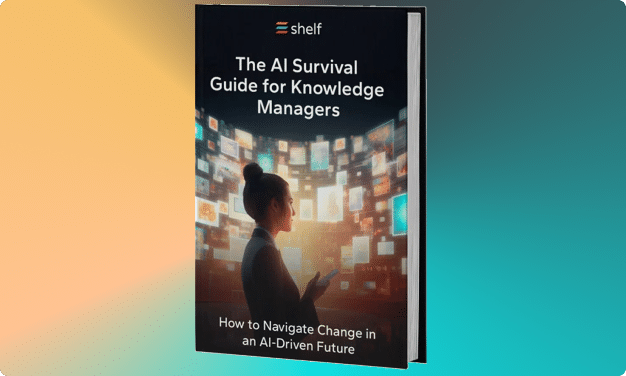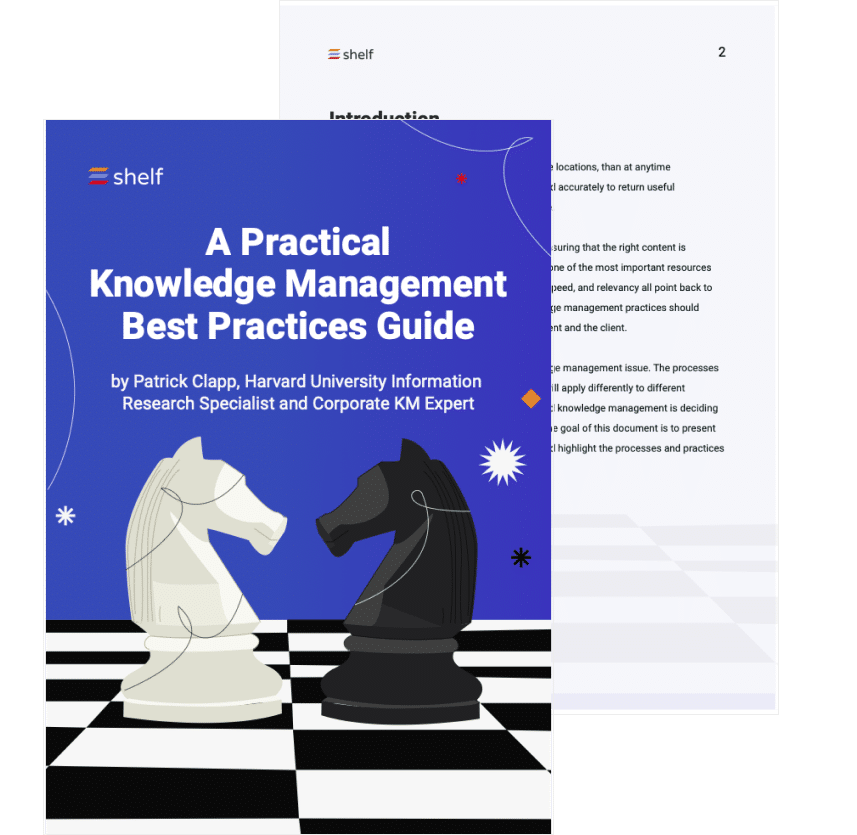If you work in an enterprise organization, eventually knowledge management must be taken seriously; more than a ‘nice-to-have’, or just another buzzword—enterprise knowledge management involves much more than a simple knowledge base or company intranet site.
If we take a step back, knowledge management is all the people and processes and technology that enable people share, access, and manage helpful information within an organization. The goal of KM is to make sure that the right people have the right information at the right time so they can make better decisions and do their jobs more effectively.
What is enterprise knowledge management?
Enterprise knowledge management is how an organization manages the people, processes, and technology involved in maintaining and distributing knowledge to thousands of customers across a variety of support channels.
To distribute and maintain knowledge at the enterprise level, you need more than simple knowledge base software—you need an enterprise knowledge management platform as the technology foundation of your overall KM system.
All the systems and tools to manage knowledge should ideally be defined in a documented framework. A knowledge management framework (we’ll cover later) contains a description of all components of the knowledge management system; as an organization grows, the right knowledge framework provides the instructions for how all the moving parts work together.
Knowledge management at the enterprise level can get involved, but to keep it simple, below is a simple structure to understand how these knowledge-related terms related to one another.
Knowledge management framework
The overarching structure in any enterprise knowledge management strategy; includes the overall KM system plus governance, knowledge capture, and more.
Knowledge management system
Your enterprise KM system will consist of the following:
- Knowledge management technology: KM tools like an enterprise knowledge management platform
- People: basically your entire knowledge management team (which can include customers and employees!)
- Defined processes around knowledge maintenance, feedback, and how people work together.
In today’s knowledge-driven economy, enterprises need the right system to make knowledge helpful, they need the right technology to make use of all of the big data related to knowledge.
Benefits of enterprise knowledge management
EKM offers an array of benefits to businesses. For example, it can improve your organization’s:
- Decision making. EKM can help your business make better decisions by ensuring that key actors have access to the latest information and research as well as the collective knowledge within the enterprise.
- Efficiency. EKM systems can automate tasks and processes, saving your company both time and money.
- Customer service. Your company can improve its customer service by giving employees quick and easy access to all the information they need.
- Collaboration. An EKM system can help improve your company’s communication and collaboration by allowing knowledge workers to access and share information from its centralized storage location.
- Competitiveness. Your business can gain a competitive edge by using EKM to ensure that knowledge is captured, stored, shared, and used in the most efficient way possible.
Challenges of enterprise knowledge management
Despite the benefits, there are some challenges businesses face when implementing enterprise KM systems. These challenges include:
- Organizational buy-in. EKM requires organizational buy-in from employees, managers, and executives for the system to function comprehensively.
- User training. Some vendors in the enterprise KM space don’t offer great trained on how to implement KM software. Find a partner, not just a technology vendor.
- Accuracy of information. Some enterprise KM solutions don’t make it easy to keep accurate and up-to-date information in the system.
- Maintenance. Some enterprise KM solutions (especially legacy solutions) don’t leverage AI and require lots of ongoing maintenance.
- Data overload. Data overload is a risk enterprises face when they outgrow a knowledge base. Overload can occur when a system contains too much data, some of which may be outdated, redundant, or otherwise unnecessary to store.
- Security breaches. All businesses face some risk of security breaches. Enterprise KM systems may contain sensitive information vendors must address.
All knowledge management challenges can be overcome with proper planning and execution. In the knowledge economy, businesses that don’t find a way to manage their knowledge effectively will find themselves at a competitive disadvantage.
Enterprise knowledge management frameworks
There are various EKM frameworks available to businesses. But before you can choose the right framework for your organization, you need to understand why it’s important to do so.
Why choose a framework?
A framework provides a structure. It will help your business identify the policies, processes, and technologies needed to support its knowledge management initiatives.
Here are some additional benefits of using a framework:
- It helps to align your KM system with your business objectives.
- It provides a roadmap for implementing EKM.
- It helps to ensure that your EKM is consistent across the organization.
- It provides a structure for measuring the success of EKM initiatives.
How are frameworks applied?
EKM frameworks can be applied in either a top-down or bottom-up manner. In a top-down implementation, a framework is chosen and the KM system is implemented across the organization to fit the framework. In bottom-up applications, organizations start with the system, followed by a framework is chosen to support it.
Which framework is right for your organization?
This depends on your organization’s specific needs. You’ll want to consider factors such as the size of your organization, the type of knowledge you need to manage, and the maturity level of your EKM initiative.
The most common EKM frameworks are:
- Knowledge Management Maturity Model (KMMM). The KMMM can help your organization assess its KM maturity and identify areas for improvement. It’s a useful tool for those just starting out on their EKM journey.
- Knowledge Management System Framework (KMSF). The KMSF provides guidance on designing, developing, and implementing a KM system.
- Enterprise Knowledge Management Framework (EKMF). The EKMF helps in the planning, implementation, and management of EKM initiatives. Each process in the EKMF is mapped to a specific set of activities, tools, and techniques.
- Zachman Framework. The Zachman Framework can help your company design, develop, and implement EKM systems. The elements within the framework can be customized to fit the specific needs of your organization.
- Chief Knowledge Officer (CKO) Success Framework. Your organization can use the CKO Success Framework to identify and assess your KM needs.
To serve your customers, your KM framework and system should handle a few simple functions related to knowledge–let’s cover a few of the basic ones.
Basic functions of an enterprise knowledge management
- Knowledge capture. Capturing knowledge is the process of transforming tacit knowledge (unshared knowledge stored in people’s minds) into explicit knowledge (knowledge that can be communicated and utilized by others). This can be done via interviews, focus groups, and document analysis, among other activities.
- Knowledge storage. Once knowledge has been captured, it needs to be stored in a central repository where it can be easily accessed and shared by people who need it. This is typically done using a content management system (CMS).
- Knowledge sharing. Knowledge sharing is the process of making knowledge available to those who need it using various communication platforms, knowledge portals, and collaboration tools.
- Knowledge use. Using knowledge means putting it to work to achieve organizational objectives. Knowledge use typically occurs during activities like decision-making, problem-solving, and innovation.
Features of an enterprise knowledge management platform
You can’t accomplish the KM system functions outlined above without the right technology. As we mentioned, a knowledge management platform will be the core knowledge management tool enterprise use; these tools will help facilitate actions like knowledge sharing and access.
Here are a few basic features to look for in any enterprise knowledge management software platform.
- Content management system: A simple CMS or database will store all content types within a knowledge management platform. It provides a central repository for storing and organizing different types of content like FAQs, wikis and or decision trees.
- Collaboration: On the customer-facing side and backend of the KM platform, built-in knowledge management features like commenting or user tagging can help. These tools help knowledge workers communicate and work together more effectively.
- Search: Search technologies appear in most basic knowledge bases, but enterprises require pinpoint search features; search that can find text within documents, search that returns results based on predictive models.
Common team roles in enterprise knowledge management
Enterprises aren’t just driven by technology — they require people to function as well. For an enterprise knowledge management system to be successful, you need to have the right people involved in the process.
Here are some of the roles you’ll need to fill for a successful EKM initiative:
- Knowledge workers. Knowledge workers are the people who create, use, and share knowledge within an organization. Your organization’s knowledge workers might be found in your marketing, sales, customer service, R&D, and human resources departments, among others.
- Knowledge managers. Knowledge managers are responsible for overseeing the KM process. They develop strategies for knowledge capture, storage, and sharing and ensure that the right people have access to the right knowledge at the right time.
- IT staff. IT staff members play a critical role in developing and maintaining the technology infrastructure that supports the overall KM system.
View our post on KM roles and responsibilities for tips to help set up your team.
7 tips to implement an enterprise knowledge management system
Now that you have an idea of what’s involved in an enterprise knowledge management system implementation, here are some important tips to help guide you along the way.
1Define your goals
What do you want to achieve with your enterprise knowledge management system? Do you want to improve communication and collaboration? Increase efficiency? Make better decisions? Be specific, and ensure you have buy-in across the organization.
2Consider your budget
Since enterprise systems require technology, maintenance, and the right people— they require investment. Consumer-grade software and technology won’t cut it in the enterprise, so plan for a partnership with your KM vendor as you develop your strategy.
3Identify key stakeholders
Decide who will be using the system and who will be responsible for managing it—list out owners and contributors to your overall KM strategy.
4Choose the right software
There are many knowledge management software applications available. Choose one that best meets the needs of your organization today—whether your org is B2C, B2B, or neither.
5Train your employees
Enterprise KM software can do a lot—you need a team to guide you through onboarding and implementation process.
6Plan for change
Any enterprise KM initiative requires buy-in and change. Think about your overall change management checklist with any new implementation.
7Implement and manage the system
Any enterprise KM initiative requires buy-in and change. Think about your overall change management checklist with any new implementation.
After implementation, you’ll have to monitor the system to ensure its achieving the desired results. Any system requires ongoing maintenance and updating. Inaccurate information (like a subpar knowledge base) in an enterprise system can lead to bad decisions, and increasing costs.
No matter how you structure your knowledge management strategy, all enterprise systems require planning, collaboration, communication, and organizational change to be effective.





